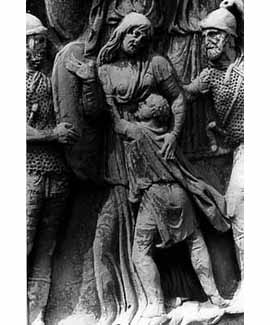|
Slavery to Serfdom
Scenes like this one, where an enslaved mother
and her son from a defeated Gallic tribe are being torn apart forever,
will have been relatively rare after the mid-2nd century A.D. But
anyone who would read into the subsequent dwindling of the slave population some sign of
a kinder world-view among the Roman citizenry would be way off the
mark. The coming of Christianity
did not improve the lot of slaves at all—indeed, some would argue that
it was now far worse. One of the foremost Christian moralists of
the day did state: "He did not intend that His rational creature,
who was made in His image, should have dominion over anything but
the irrational creation—not man over man, but man over the
beasts." (St. Augustine, The City of God XIX.15). Yet,
within the space of a paragraph, that same writer observed:
"The prime cause of slavery is sin, which brings man under
the dominion of his fellow."
Most slaves were employed in urban households,
to handle the usual run of domestic duties. (Lack of at least two
or three slaves would have been viewed as a middle-class Roman's
slide towards poverty—as symptomatic in this regard as renting,
as opposed to owning, his lodgings.) It may be that slaves did carry
out the most menial tasks in the craft workshops of the Eastern
provinces. But the workshops now were run by freeborn men who were
caught up in a cycle of borrowing and payment-in-kind that left
only a small amount of cash income upon which to build the dream
of owning their own business. For many men, failure in such
ventures resulted in a crushing burden of debt that, in essence,
reduced their status to serfdom.
|
|

Relief depicting child
enslavement
Column of Marcus Aurelius
Piazza Colonna, Rome
|

